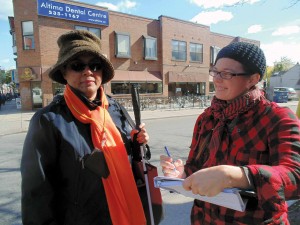Research measures economic impact of pilot bike lanes

Kelsey Carriere (right) interviews a legally-blind member of a tandem bicycling club that travels along Harbord Street. Carriere is part of the team studying the demographics of Bloor Street West between Shaw and St. George streets before and after the installation of a pilot bike lane in April 2016. Summer Reid, Gleaner News
By Summer Reid
A study investigating the demographics of Bloor Street began last month in the Annex. Aimed at understanding how people travel to and from the area, and what business they conduct along the street, it will also measure what impact, if any, the April 2016 installation of a pilot bike lane on Bloor Street West between Shaw and St. George streets will have on the area’s businesses.
The University of Toronto will conduct the study in partnership with the Toronto Centre for Active Transportation (TCAT). It will cost $22,500, and is being paid for by the Bloor-Annex and Korea Town business improvement areas (BIAs), which have committed $6,500 and $4,000 respectively, with the Metcalf Foundation, a local charitable organization, contributing the balance.
“The idea is to get an overall demographic of who uses Bloor Street and how they get there, by what modes of transportation, what degree of regular customers these people are, how far they come from,” related Kelsey Carriere, a member of the crew conducting the study from the University of Toronto. “Right now we’re doing customer surveys, merchant surveys, and cyclist counts. Then after the bike lane pilot project is installed by the City of Toronto next year, we’ll come back in a year’s time and we’ll do the same study.”
She said that six people are conducting the surveys, with three pairs each going to the Annex, Korea Town, and the Danforth.
“Since the City of Toronto is looking at putting in the pilot project on the stretch of Bloor Street including both the Annex and Korea Town BIAs, that’s our study group,” he explained. “And then the Danforth is our control group, so we can see if there are any overall changes in demographics in cycling, for example, throughout the city in general. And then we can pull out if there’s anything that we can specifically relate to the bike lane pilot project.”
The bike lane pilot project is part of a 10-year cycling plan that Toronto City Council approved on Sept. 30. The trial may necessitate a 50 per cent reduction in parking along Bloor Street, and the BIAs would like to measure the economic impact of the bike lanes on their members throughout the trial period.
“Research shows that over 70 per cent of Torontonians would cycle more often if infrastructure were improved,” said Andre Vallillee, the director of the Environment Program for the Metcalf Foundation. “We think [this is] a great opportunity for Metcalf to partner with two local BIAs to support timely research by a well-respected organization. As an Annex-based organization, we value the vibrancy of this neighbourhood, and are drawn to the fact that the study will explore the local economic impacts of bike lanes along a corridor we frequent often by bike and by foot.”
“The need for a study is clear in my mind,” said Bloor-Annex BIA board member Jonathan DaSilva of Hot Docs Cinema. “Getting answers as to what the impact would be directly on businesses is something that we need to know to move forward on the issue.”
Although the study is moving forward, not all of the members of the Bloor-Annex BIA board were in agreement. One objected to having the study conducted through U of T and TCAT, while another wondered if spending money on a study was actually necessary.
“Is it worth it to really study the obvious that we’re going to know anyway?” asked Sumit Kapur of Future Bakery. “I just can’t see the value in something like that, [because] if we’re going to have a pilot project, we’re going to know the impact through the merchants.”
“[We] need to know, locally, what the impact is,” said Joe Cressy (Ward 20, Trinity-Spadina). “We don’t normally do this as a city. Normally you have councillors who say ‘we support bike lanes, our residents want bike lanes so, we’re going to put in bike lanes’ and then we hear anecdotally whether it’s good or bad.”
Carriere said the study is also researching what people think about the idea of a bike lane pilot project, and is finding that “it’s actually incredibly inspiring how much people have thought about it”.
Brian Burchell, the publisher of this newspaper, is also the chair of the Bloor-Annex BIA
